SG10
| Location: Bald Hills. | Australian Soil Classification: Parapanic, Humosesquic, Aeric PODOSOL; very thick, sandy/sandy. |
| Northcote Factual Key: Uc 2.32. | Great Soil Group: podzol. |
| Geology: Quaternary sands. | General Landscape Description: Narrow low east/west dune. |
| Soil Mapping Unit: Heath Mounds. | Site Description: Sand dune with native vegetation (within a grazing paddock). |
| Native Vegetation: Includes: Gippsland Mallee (Eucalyptus kitsoniana). | |
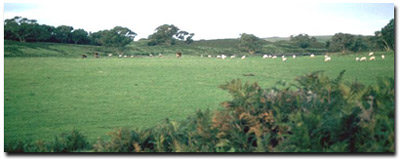 Site SG10 Landscape |
Soil Profile Morphology:
| Surface Soil | 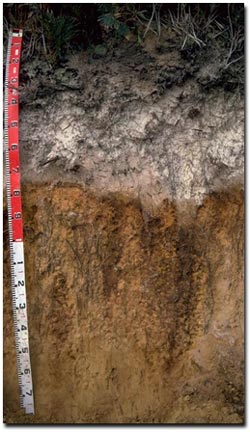 Site SG10 Profile | ||
| A1 | 0-30 cm | Dark grey (10YR4/1); loamy sand; loose surface condition; structureless; pH 5.5; clear change to: | |
| A2 | 30-75 cm | Light grey (10YR7/2); sand; structureless; pH 5.7; clear and wavy change to: | |
| Subsoil | |||
| Bhs | 75-140 cm | Strong brown (7.5YR5/8) and dark reddish brown (5YR3/3); sand with tongues of variably cemented "coffee rock"; structureless; firm to strong consistence dry; pH 5.6; diffuse change to: | |
| C | 140+ cm | Brownish yellow (10YR6/6); sand; structureless; pH 5.5. | |
Key Profile Features:
- High sand content throughout the profile.
- Presence of subsoil accumulation of iron and organic matter (i.e. "coffee rock").
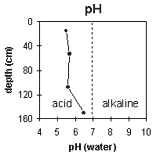 | 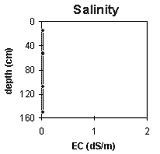 | 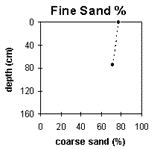 | 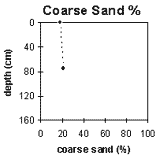 |
The soil is strongly acid in the upper profile and becomes moderately acid below 1 m depth. | Total soluble salt levels are very low throughout the profile. | The soil profile has a high sand content throughout. | |
Horizon Depth (cm) | pH water | pH CaCl2 | EC 1:5 | Exchangeable Cations | Ex. Al mg/kg | Ex. Acidity meq/100g | Wilting Point pF 4.2 | Coarse Sand (0.2 - 2 mm) | Fine Sand (0.02-0.2 mm) | Silt (0.002-0.02 mm) | Clay (<0.002 mm) | ||||
Ca | Mg | K | Na | ||||||||||||
meq/100g | |||||||||||||||
A1 | 0-30 | 5.5 | 4.2 | <0.05 | 0.1 | 1.6 | 0.1 | 0.1 | 4.3 | 18 | 77 | 1 | 1 | ||
A2 | 30-75 | 5.7 | 4.4 | <0.05 | |||||||||||
Bhs | 75-140 | 5.6 | 4.8 | <0.05 | 0.4 | 0.1 | 0.1 | <0.1 | a | a | 3.4 | 21 | 71 | 1 | 3 |
C | 140+ | 6.5 | 5.5 | <0.05 | |||||||||||
Management Considerations:
Whole Profile
- Plant Available Water Capacity (PAWC) is considered to be very low (estimated at approximately 45 mm). This is based on available laboratory data and assumes an effective rooting depth of 70 cm. Rooting depth is likely to be limited by the "coffee rock" layer. Rooting depth may well be shallower as the strongly leached A2 horizon is very infertile and does not provide favourable conditions for plant growth. Most of the plant available water (i.e. 32 mm) is likely to be held in the A1 horizon.Similar soils to these are used for intensive vegetable cropping in the Cranbourne region. These sandy soils retain little water and are very low in nutrients. However, with irrigation, fertilisers and additional organic matter they can become highly productive. The main attraction of these soils is that they can be cultivated throughout most of the year. The 'coffee rock' layer can sometimes impede the downward movement of water, in which case subsurface drainage may be required.
- Surface (A) Horizons
- The sandy surface horizons are very well drained and have a low water storage capacity. The low wilting point value (i.e. 4%) indicates that plants will be able to utilise light rains falling on relatively dry soils. However, due to the low water storage capacity, plants will soon suffer moisture stress unless further rainfall occurs. Organic matter is important in these sandy soils to enhance water holding capacity.
- The surface soil will be prone to wind erosion if plant cover is removed.
- Deficiencies of trace elements such as copper, zinc and molybdenum are likely to occur, but should be confirmed by plant tissue analysis.
- The surface soil has a very low inherent fertility (based on the sum of the exchangeable basic cations). Such strongly leached soils are also likely to be naturally deficient in nitrogen, phosphorus, sulphur and potassium. Regular fertiliser inputs are required for improved pasture or vegetable cropping. Nitrate and sulphate are readily soluble and easily removed by leaching. More regular but smaller applications of fertiliser will assist in reducing loss of nutrients through leaching and is likely to be deficient in nitrogen, phosphorus and potassium.
- The sub-surface (A2) horizon is extremely infertile, so building up the surface (A1) horizon should be an objective.
- Lime application will result in increased pH levels and make certain nutrients such as phosphorus more available to plants. Many vegetables prefer a pH closer to 6.5. Burnt lime is preferred when planting Brassica species or when a rapid pH change is required (pers. comm. Geoff Morrow, State Chemistry Laboratory).
- Deficiencies of the trace element molybdenum (Mo) are likely to occur in acid sandy soils (soil adsorption of Mo increases as pH decreases, leading to reduced availability to plants). U.S.A research has found that the following vegetables can be susceptible to molybdenum deficiency: Brassica species (e.g. cauliflower, broccoli and cabbage), lettuce and tomato (Clark 1984). Any deficiencies can be confirmed by plant tissue analysis. Deficiencies can be remedied with molybdenum-enriched fertiliser and foliar application. Lime application on acid soils will also make molybdenum more available to plants.
- Nutrients such as calcium and magnesium are usually low in strongly acid soils. Magnesium deficiency has been found to affect vegetables such as tomatoes, potatoes and cauliflowers (NSW Dept. Agric. 1987). Magnesium deficiency can be assessed by plant tissue analysis and can be treated by applying dolomite to the soil or using a foliar spray. Calcium deficiency can affect vegetable crops such as tomatoes, lettuce, celery, brussels sprouts and potatoes (NSW Dept. Agric. 1987). Foliar spray application, adjusting soil pH with lime application or using calcium based fertilisers can be utilised to treat deficiencies.
- The trace element boron (B) leaches rapidly through acid sandy soils and deficiencies are likely to occur. Susceptible crops include cauliflower, cabbage and celery (NSW Dept. Agric. 1986). Over-liming in sandy soils can make trace elements such as boron, zinc and manganese less available. Organic matter can complex with metal ions enabling trace elements (Fe, Zn, Cu) to become more available to plants.
- Organic matter is an important source of nutrient holding capacity in sandy soils. Levels of organic matter are often low in continually cropped vegetable growing soils and inputs such as poultry manure are often recommended.
- The "coffee rock" layer may restrict the downward movement of plant roots and water. In some situations, the build up of water on top of the less permeable layer may be beneficial in that it prevents deep drainage of water away from plant roots.


